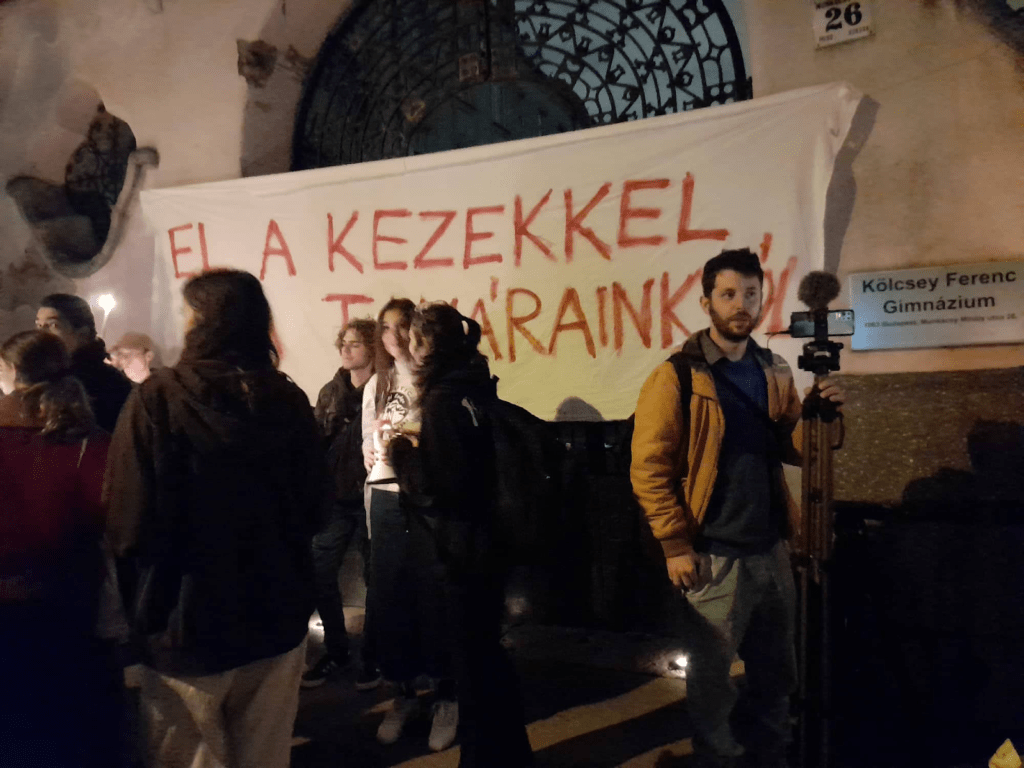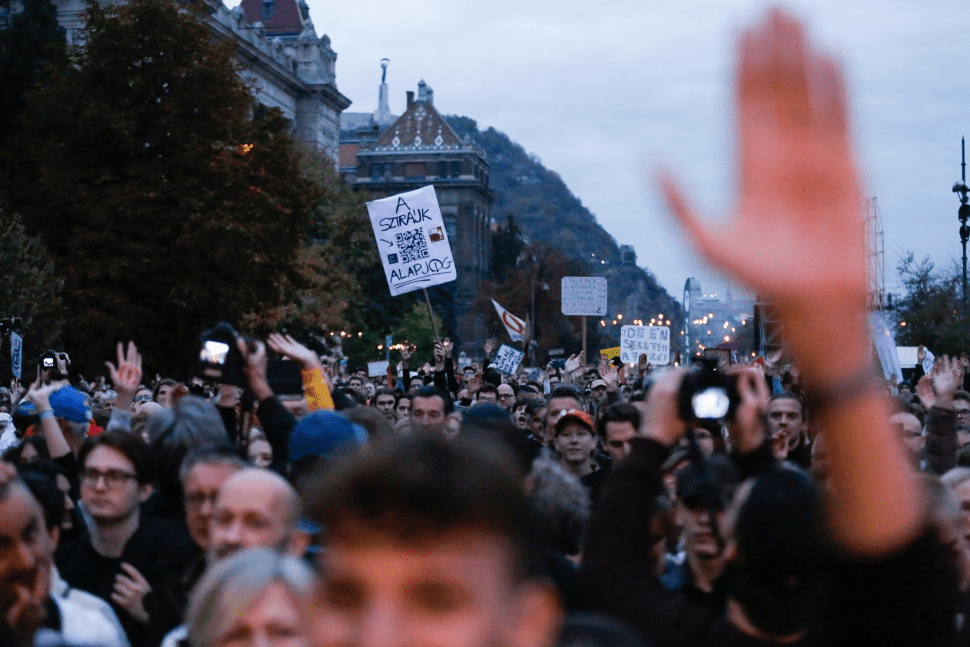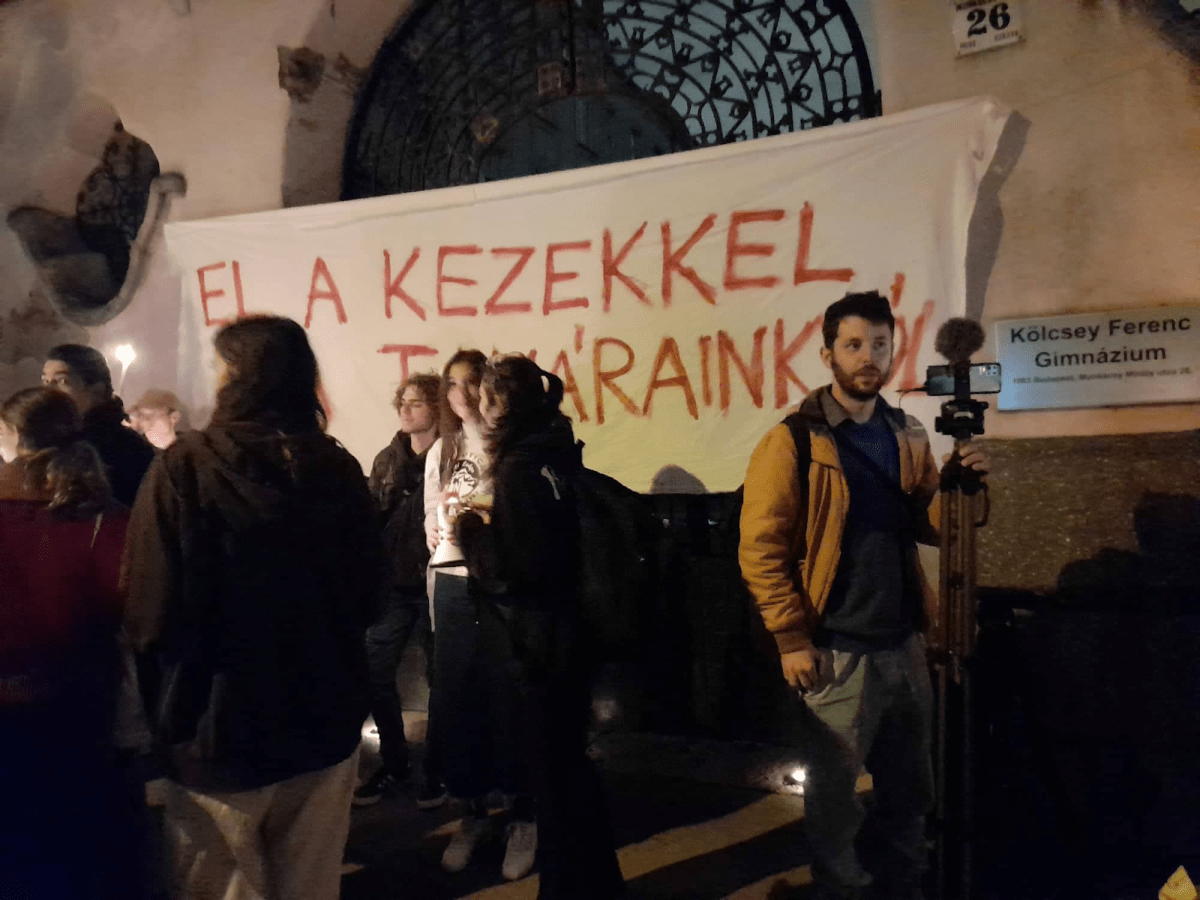
Note from LeftEast editors: Problems stemming from deteriorating working conditions and low salaries for teachers in Hungarian public education have been accumulating over the years, a process which intensified further during the Covid-19 crisis. Such a development resulted in an acute shortage of teachers as well as an alarming situation in public education, and occurred also due to severely limited collective bargaining opportunities in the public sector in Hungary via restrictive strike legislation in place since 2011. Education policies of the Hungarian populist government also pushed many public education institutions towards “Church takeover”, or hybrid forms with an increased role of the Church in terms of both finance, maintenance and employment relations. Irrespective of difficulties of organizing legal collective action, in early February 2022, teachers unions managed to organize a two-hour warning strike and announced a full day strike for March 15 2022 – only to find out days later, that a governmental decree again changed the rules of the game for launching a legal collective action. Since March 15, 2022, a diversification and enlargement of the protests has occurred: many teachers started civil disobedience actions, protests followed involving not only teachers but parent groups and students, civil society organizations as well as local communities. In an updated version of the article originally published on Eastblog, Blog der Forschungsgruppe Osteuropa am Institut für Politikwissenschaft der Universität Wien, on October 27, 2022, Imre G. Szabó provides an analysis of the protest movement since the April 2022 general election and the political-economic context in which teacher and student protests have been unfolding. To illustrate the extent and colorfulness, the main messages and repertoire of the protest movement, we use the collected, documented and publicly available photos of the Hungarian Teachers’ Trade Union (Pedagógusok Szakszervezete – PSZ) and the Hungarian Democratic Teachers Union (Pedagógusok Demokratikus Szakszervezete – PDSZ) – with their acknowledgement. Here is a photo gallery of the protest on October 23 2022 in Budapest and an increasing number of films documenting protests in schools, and in public space in regional towns and the capital. Protests are still ongoing. The last in the repertoire are human chains. They are co-organized by unions, civil society organisations, student organisations and parental associations. there was a large protest on November 18, 2022, a nationwide strike is announced for December 8 2022, as well as a protest for December 9 2022.
If not otherwise indicated, photo captions are by LeftEast.
Despite the crushing defeat of the opposition at the elections in Spring this year, not all is quiet in Orbán’s Hungary. Teachers, students, and parents have organized a series of protests across the country in recent weeks, calling on the government to increase teachers’ salaries, restore teaching autonomy and create a more democratic education governance. The strong participation of high-school students adds symbolic value to the protests. Hungary is a rapidly aging society, but it is governed by a party that bears “youth” in its name. (Orbán’s FIDESZ was established as the Alliance of Young Democrats in 1988. Orbán is now 59 and FIDESZ – despite its dominance across all age groups – is polled to be relatively unpopular[i] among young voters). Teachers’ salaries are at the center of the current discontent, which has broader implications for the role of education in an illiberal regime.
Strike, civil disobedience, and retaliation
The direct trigger for the present wave of protests was the dismissal of a group of teachers from a Budapest high school early October 2022. The dismissed teachers engaged in civil disobedience by not delivering lessons one day per week– an alternative form of work stoppage after the government put an almost complete ban on effective strike activity.
Strike law had always been restrictive in Hungarian education: picketing is forbidden, and teachers must provide supervision for children even if instruction stops. The Orbán government tightened these rules further in the wake of a relatively successful strike this Spring, prescribing near-normal operation for schools during a strike. While the right to strike is not formally tied to trade union membership, in practice it is further hindered by the low membership of teachers’ unions who are struggling to get recognition from the government as bargaining partners. Despite the weakness of trade unions and the de facto prohibition of strikes, street demonstrations and alternative forms of protest proliferated in recent years, mostly thanks to a vibrant scene of social movement organization of teachers, students and parents that has emerged since 2016, and that works in cooperation with trade unions.
Teaching out of duty
The protest demands focus on wages as Hungarian teachers’ salaries are very low in international comparison. Teachers in lower secondary education take home 60% of the average earnings of tertiary-educated workers, and this is the lowest figure within the OECD[ii]. Teachers’ wages in Hungary have been subject to government unilateralism and political cycles even before Orbán. During the early 2010s, teachers received a conditional salary increase that was linked to the introduction of a cumbersome promotion system and to increased workload. Since 2015, their salaries have stagnated while the minimum wage and private sector wages increased relatively fast due to labour shortages and an economic boom until the pandemic. Labour shortages have become a critical issue in education too, especially in specializations such as foreign languages or STEM subjects. The age profile of the profession also suggests that without making teaching more attractive, shortages will further increase. In 2019, 45 percent of schoolteachers in Hungary were 50 years or older.
The protests also have a strong gendered dimension as more than 90% of primary and 75% of secondary school teachers are women[iii]. The protesters are aware of the implications of this imbalance for professional prospects. One theme that often comes up in slogans is that you need a well-earning husband to be able to stay in the profession. At the same time, the government relies on gendered stereotypes to influence public opinion against protesting teachers. Recently, the speaker of the parliament, László Kövér referred to teaching as an activity that decent teachers perform out of duty, irrespective of their salary levels[iv]. Anti-gender equality is a subtext of government communication, and there is no direct attack on teachers as a mostly female profession. However, the statements like the one from Kövér fit the general narrative of government officials and government-sponsored organizations that “women should know their place”, that equal wage for equal work is not always applicable, and that there are too many women with university degrees.
Centralization and militarization of public services
Increased centralization and militarization of public services in Hungary is couched in the language of duty. The teachers, whose dismissal triggered the current protests, received their notice from the district education authority – a bureaucratic management board that is located in a school on the other side of the city, indicative of the centralization of Hungarian education since 2010.
Before 2010, local governments were responsible for the provision of pre-tertiary education in Hungary. Since Orbán took power in 2010, a process of centralization has been taking place. As the most recent and most extreme step in this process, pre-tertiary general education was ordered under the Ministry of the Interior in May 2022, together with health- and social care. The ministry is led by Sándor Pintér, a former police chief, and one of Orbán’s most trusted allies.
Centralization also means the curtailment of decision-making and budgetary autonomy at the lower levels of education. In the vision of the ruling party, the operation of education should resemble the hierarchical structures of public administration, police, and the military. In the government’s narrative, women’s duty to care and teach irrespective of salary levels and the state employees’ militarised duty to obey orders fit together and reinforce each other. This view is also reflected in the decreasing autonomy of teachers regarding the curriculum. While these hierarchical structures were compatible with the expansion of public education in the 19th and 20th century and eventually proved to be a tool for social mobility, Orbán’s new conservatives have made steps in the opposite direction. They have tightened access to education by lowering the age of compulsory education to sixteen, reduced enrollment in public higher education and disinvested from general skills in favour of vocational training. For the better-off, government-supported religious schools and private education opportunities abroad provide the costly alternative.

Holding teachers hostage
The government now wants to finance the long-term upgrade of teachers’ salaries from EU funds. This decision however also means that the increase in teachers’ salaries is conditional upon an agreement with the European Commission on Hungary’s development funding from the EU’s 2021-2027 budget framework. The agreement has been held up by the dispute between the Hungarian government and the Commission about the rule of law and anti-corruption measures. In this way, teachers have become hostages in a transnational dispute and the Hungarian government can blame Brussels for the lack of progress on the issue.
In the meantime, the jury is out on the persistence of the protests. Earlier cycles of discontent against the Orbán regime (either in education or in other areas) fizzled out, and at the moment education authorities are also holding back from escalating the situation by further dismissals. The protests have nevertheless spread from competitive, middle-class-frequented high schools in Budapest to more run-of-the-mill schools in smaller towns and even to kindergartens. And in any case, it is often the squeezed middle classes that provide the spark for more fundamental changes. Teachers are white-collar employees who are nevertheless wage labourers and who are squeezed by a particular form of authoritarian capitalism on the EU’s periphery in the Hungarian case. Moreover, due to their key position in social reproduction, they could play a very important role in a broad working- and middle-class social coalition that would provide an alternative to the current regime’s socio-economic policies.

Imre G. Szabó is visiting faculty at Central European University, Vienna. His research focuses on labor politics and public service governance in a European comparison.

